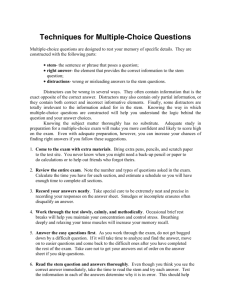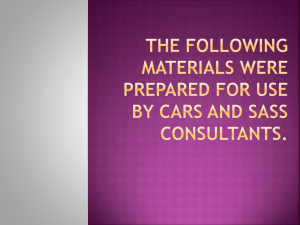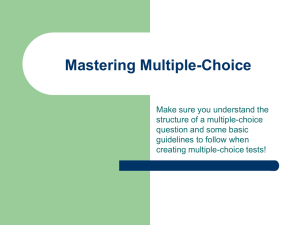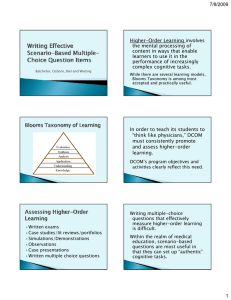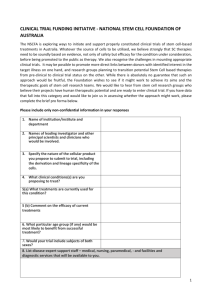Instructional Assessment Resources-MCI
advertisement
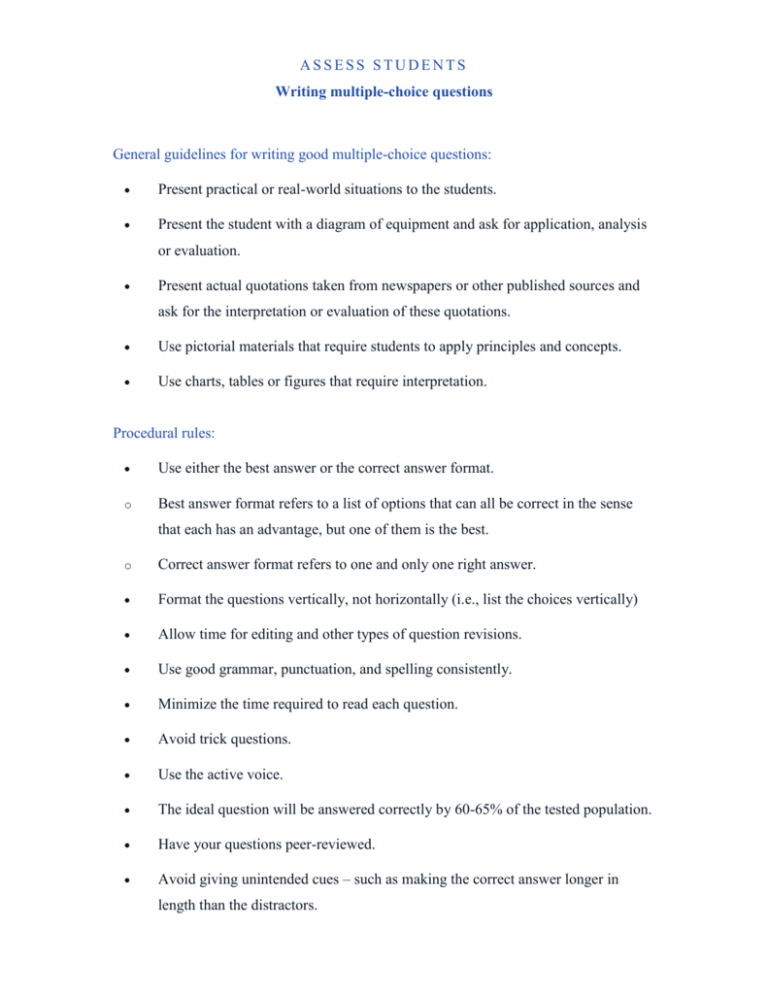
ASSESS STUDENTS Writing multiple-choice questions General guidelines for writing good multiple-choice questions: Present practical or real-world situations to the students. Present the student with a diagram of equipment and ask for application, analysis or evaluation. Present actual quotations taken from newspapers or other published sources and ask for the interpretation or evaluation of these quotations. Use pictorial materials that require students to apply principles and concepts. Use charts, tables or figures that require interpretation. Procedural rules: Use either the best answer or the correct answer format. o Best answer format refers to a list of options that can all be correct in the sense that each has an advantage, but one of them is the best. o Correct answer format refers to one and only one right answer. Format the questions vertically, not horizontally (i.e., list the choices vertically) Allow time for editing and other types of question revisions. Use good grammar, punctuation, and spelling consistently. Minimize the time required to read each question. Avoid trick questions. Use the active voice. The ideal question will be answered correctly by 60-65% of the tested population. Have your questions peer-reviewed. Avoid giving unintended cues – such as making the correct answer longer in length than the distractors. Content-related rules: Base each question on student learning objective of the course, not trivial information. Test for important or significant information. Focus on a single problem or idea for each exam question. Keep the vocabulary consistent with the students’ level of understanding. Avoid providing cues from one question to another; keep questions independent of one another. Use examples from course materials as a basis for developing your questions. Avoid overly specific knowledge when developing questions. Avoid textbook, verbatim phrasing when developing the questions. Avoid questions based on opinions. Use multiple-choice to measure higher level thinking. Be sensitive to cultural and gender issues. Stem construction rules: State the stem in either question form (When did World War II begin?) or completion form (World War II began in ______.) The blank in completion questions should always be at the end of the stem. Stem directions should clearly indicate to students exactly what is being asked. EXAMPLE 1. (Original-vague stem) World War II was: A. The result of the failure of the League of Nations. B. Horrible. C. Fought in Europe, Asia, and Africa. D. Fought during the period of 1939-1945. 1. (Revised) In which of these time periods was World War II fought? A. 1914-1917 B. 1929-1934 C. 1939-1945 D. 1951-1955 E. 1961-1969 Avoid window dressing (excessive verbiage) in the stem. Word the stem positively; avoid negative phrasing such as “not” or “except.” If this cannot be avoided, the negative words should always be highlighted by underlining or capitalization: Which of the following is NOT an example …… Include the central idea and most of the phrasing in the stem. Avoid giving clues such as linking the stem to the answer (…. Is an example of an: test-wise students will know the correct answer should start with a vowel) General option development rules: Place options in logical or numerical order. Use letters in front of options rather than numbers; numerical answers in numbered questions may be confusing to students. Keep options independent; options should not be overlapping. EXAMPLE 1. (Original-non mutually exclusive options) During what age period is thumb-sucking likely to produce the greatest psychological trauma? A. Infancy B. Preschool period C. Before adolescence D. During adolescence E. After adolescence 2. (Revised) During what age period is thumb-sucking likely to produce the greatest psychological trauma? A. From birth to 2 years old B. From 2 years to 5 years old C. From 5 years to 12 years old D. From 12 years to 20 years old E. 20 years of age or older Keep all options homogeneous in content. Keep the length of options fairly consistent (preferably short) Avoid, or use sparingly, the phrase all of the above. Avoid, or use sparingly, the phrase none of the above. Include from three to five options for each question. More than five options does not help discriminate performance Also, it is difficult to write more than five good options Avoid the use of the phrase I don’t know. Phrase options positively, not negatively. Avoid distractors that can clue test-wise examinees; for example, absurd options, formal prompts, or semantic (overly specific or overly general) clues. Avoid giving clues through the use of faulty grammatical construction. EXAMPLE 1. (Original-faulty grammatical construction) Albert Eisenstein was a: A. Anthropologist. B. Astronomer. C. Chemist. D. Mathematician 2. (Revised) who was Albert Einstein? A. An anthropologist. B. An Astronomer. C. A chemist. D. A mathematician. Avoid specific determinates, such as never and always. Position the correct option so that it appears about the same number of times in each possible position for a set of questions. Make sure that there is one and only one correct option. The greater the similarity among alternatives, the greater the difficulty. EXAMPLE 1. (Easy) who was the President of the U.S. during the War of 1812? A. Grover Cleveland B. Abraham Lincoln C. James Madison D. Harry Truman E. George Washington 1. (More difficult) who was President of the U.S. during the War of 1812? A. John Q. Adams B. Andrew Jackson C. Thomas Jefferson D. James Madison E. George Washington Distractor (incorrect options) development rules: Use plausible distracters. Incorporate common errors of students in distracters. Avoid technically phrased distracters. Use familiar yet incorrect phrases as distracters. Use true statements that do not correctly answer the question. Avoid the use of humor when developing options. Distractors that are not chosen by any examinees should be replaced.

